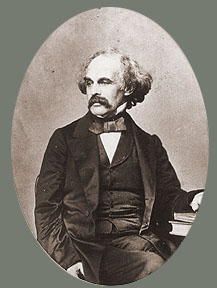The directory «Plots»
Hawthorne Nathaniel
(1804—1864)

American novelist and short-story writer, b. Salem, Mass., one of the great masters of American fiction. His novels and tales are penetrating explorations of moral and spiritual conflicts.
Descended from a prominent Puritan family, Hawthorne was the son of a sea captain who died when Nathaniel was 4 years old. When he was 14 he and his mother moved to a lonely farm in Maine. After attending Bowdoin College (1821–25), he devoted himself to writing. His first novel, Fanshawe (1829), published anonymously, was unsuccessful. His short stories won notice and were collected in Twice-Told Tales (1837; second series, 1842). Unable to support himself by writing and editing, he took a job at the Boston customhouse.
Later, Hawthorne lived at the experimental community Brook Farm for about six months, but he did not share the optimism and idealism of the transcendentalist participants (see transcendentalism), and he did not feel himself suited to communal life. In 1842 he married Sophia Peabody, a friend and follower of Emerson, Thoreau, and Margaret Fuller, and they settled in Concord. There he wrote the tales and sketches in the collection Mosses from an Old Manse (1846).
In order to earn a livelihood Hawthorne served as surveyor of the port at Salem (1846–49), where he began writing his masterpiece, The Scarlet Letter (1850). Set in 17th-century Puritan New England, the novel delves deeply into the human heart, presenting the problems of moral evil and guilt through allegory and symbolism. It is often considered the first American psychological novel. Hawthorne’s next novel, The House of the Seven Gables (1851), takes place in the New England of his own period but nevertheless also deals with the effects of Puritanism.
For a time the Hawthornes lived at “Tanglewood,” near Lenox, Mass., where he wrote A Wonder Book (1852), based on Greek mythology, which became a juvenile classic, and Tanglewood Tales (1853), also for children. At this time he befriended his neighbor Herman Melville, who was one of the first to appreciate Hawthorne’s genius. Returning to Concord, Hawthorne completed The Blithedale Romance (1852), a novel based on his Brook Farm experience.
A campaign biography of his college friend Franklin Pierce earned Hawthorne the post of consul at Liverpool (1853–57) after Pierce became President. Hawthorne’s stay in England is reflected in the travel sketches of Our Old Home (1863), and a visit to Italy resulted in the novel The Marble Faun (1860). After returning to the United States, he worked on several novels that were never finished. He died during a trip to the White Mts. with Franklin Pierce.
Aside from his importance as a novelist, Hawthorne is justly celebrated as a short-story writer. He helped to establish the American short story as a significant art form with his haunting tales of human loneliness, frustration, hypocrisy, eccentricity, and frailty. Among his most brilliant stories are “The Minister’s Black Veil,” “Roger Malvin’s Burial,” “Young Goodman Brown,” “Rappaccini’s Daughter,” “The Great Stone Face,” and “Ethan Brand.”
USA, 1983, Nathaniel Hawthorne